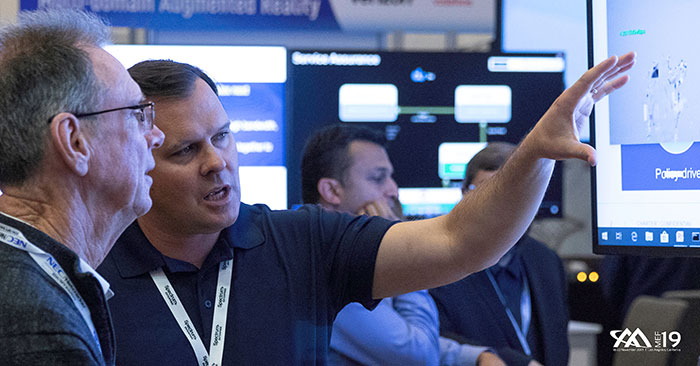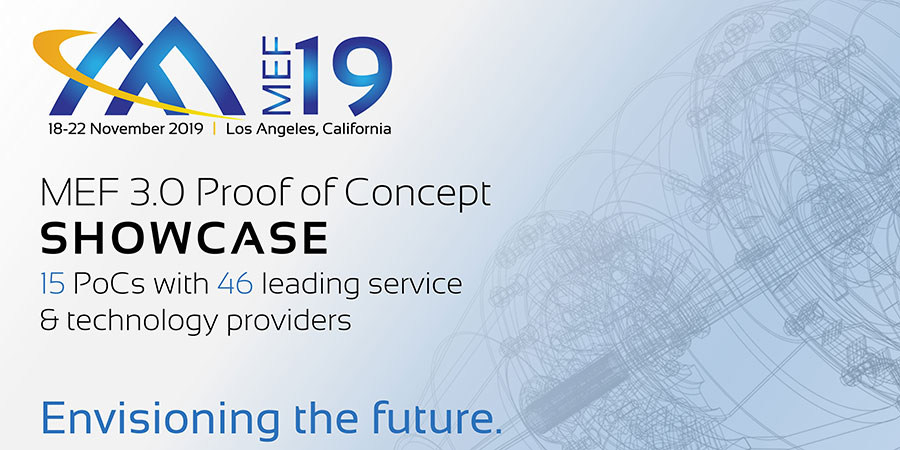For the sixth year running, MEF will showcase Proofs of Concept (PoC) at its big international event – this year, MEF19 in Los Angeles on November 18-22.
The focus this year is on demonstrating the use of different aspects of the MEF 3.0 framework to create high-value managed connectivity-based services. Each such MEF 3.0 PoC has at least three collaborating partners – service providers and/or technology vendors – that work together to use live networks and advanced technology solutions that deliver and enhance MEF-defined services with important business outcomes for the service provider industry, and their enterprise customers.
The importance of these MEF 3.0 PoCs for the participating companies manifests itself at several levels. Firstly, the MEF 3.0 PoCs trigger and accelerate inter-company collaboration and experimentation, as well as drive the engagement of different departments within each participating company to become a part of their management’s strategy for digital transformation. Secondly, MEF 3.0 PoCs encourage a better understanding of the latest work of MEF, which can help service providers deliver high-value services that span multiple operator domains and technologies. Lastly, MEF 3.0 PoCs provide an excellent opportunity for both large and small companies to highlight their market leadership position to their customers and partners – both current and future.
SD-WAN is a very central topic for MEF in general now, and in particular for the MEF 3.0 PoCs. The latest service and its attributes to be defined by MEF as part of MEF 3.0 is SD-WAN in the recently published MEF 70 standard. One MEF 3.0 PoC that includes NTT, Netcracker, Versa, Silver Peak, ADVA, and Spirent tackles an increasingly challenging issue for service providers offering SD-WAN services – how to offer and deliver a fully automated global MEF 70 SD-WAN service that uses not only multiple SD-WAN vendor solutions simultaneously, but also enables fully automated addition of features and services on request by the customer during the lifecycle of the service. The PoC also demonstrates a single pane of glass end-to-end view across multiple vendor implementations, as well as an e-commerce approach to offering different SD-WAN offerings from the provider.
Another MEF 3.0 PoC developed by CMC Networks, Intelsat, Cloudify, Kontron, Infovista, and Nuage Networks looks at how to deliver MEF 70 SD-WAN service over a combination of terrestrial and satellite connectivity infrastructure to enable terrestrial service providers to offer their enterprises almost limitless footprints with appropriate application flow support over satellite access.
The MEF 3.0 PoC developed by Telus, Ekinops, and Inmanta also demonstrates integrated orchestration of SD-WAN optimized for use of MPLS and delivery of cloud services based on MEF’s LSO (Lifecycle Service Orchestration) framework and its associated LSO APIs.
Fortinet, Spirent, and Tata Communications have developed another important MEF 3.0 PoC that demonstrates the initial principles for protecting application flows running over a MEF 70 SD-WAN service. Security assurance of SD-WAN services is becoming an increasing acute topic as attack surfaces of enterprises grow exponentially with the increased use of SD-WAN and cloud services.
Finally, the value of SD-WAN service testing and certification is highlighted by CenturyLink, Spirent, and Versa Networks, based on the release of the MEF 70 standard and the associated pilot phase of the MEF 3.0 SD-WAN certification program.
Network slicing also makes an important entry into the MEF 3.0 PoCs this year in three collaborative projects. The first of these - developed by NTT Labs, NTT Communications, and Okinawa Open Laboratory – has its roots in the rollout of 5G infrastructure in Japan. That 5G infrastructure is very expensive and is typically affordable only for established well-funded mobile operators. However, in order to make the return on investment by these operators in a reasonable timeframe, the ability to resell “slices” of the access infrastructure to smaller 5G operators that don’t have their own infrastructure but need maximum footprint for their offerings has a very compelling business proposition. Similarly, a MEF 3.0 PoC from BT, ADVA, and Infovista together with a range of radio support specialists addresses this same issue but with more emphasis on offering network slicing as a standalone orchestrated wholesale service. The MEF 3.0 PoC from AT&T, Fortinet, and Nokia looks at network slicing from the point of view of enterprises using cloud services.
Blockchain is also being highlighted in the MEF 3.0 PoCs showcasing at MEF19. The most established MEF 3.0 PoC, developed this year by Tata Communications, Sparkle, PCCW Global, Colt, Amartus, Clear, and Accedian builds on three years’ experience demonstrating provisioning of Carrier Ethernet services using LSO orchestration across multiple operators. This year, the MEF 3.0 PoC introduces the use of blockchain to automate the commercial aspect of multi-operator Carrier Ethernet on demand services together with smart contracts for billing and settlement. An additional MEF 3.0 PoC developed by DCConnect, PCCW Global, and R3 introduces the use of a blockchain-based business application for managing and monitoring the reputation of operator partners.
AI, ML, and Policy Driven Networks in the context of LSO service orchestration are highlighted in two MEF 3.0 PoCs developed by Equinix, Unitas Global, and Ciena in one group, and CenturyLink, Telia Company, and Infinera in the second group. This area of work is especially important in the context of agile services that rely on intelligent automation to remain in compliance with exacting SLAs driven by enterprises serving demanding market requirements in the digital economy.
5G, IoT, Intent Based Network, and Industry 4.0 are also addressed in several of the MEF 3.0 PoCs at MEF19. In fact, it’s impossible to neatly drop the MEF 3.0 PoCs into one category or another since they increasingly integrate a range of established and new work that MEF is actively engaged in developing to underpin service providers’ digital transformations to MEF 3.0. It’s worth noting that one of the MEF 3.0 PoCs – developed by Comcast Business, Cox Business, Ciena, and Nokia – addresses an area that has been developed for many years in MEF, namely Service Operations, Administration and Maintenance (SOAM) for Carrier Ethernet services, is also being demonstrated in the context of services spanning multiple operator domains. With all the exciting solutions being demonstrated, the established and still growing $80 billion Carrier Ethernet market also benefits from MEF 3.0 as it uses SOAM to increase visibility of all segments of the service end to end to increase customer confidence and the ability of the service provider to pre-empt SLA exceptions.
All the MEF 3.0 PoCs contribute enormously to the ongoing work at MEF by feeding back practical knowledge of implementations back into the standards work. They also form the basis for the next generation of MEF 3.0 PoCs to be showcased in 2020.

(By Daniel Bar-Lev, Director, Office of the CTO, MEF)





